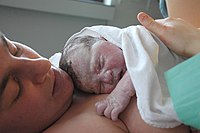
Photo from wikipedia
Background The incidence of severe maternal morbidity (SMM) during childbirth is increasing in the United States. A better characterization of risk factors for SMM may identify targets for improving maternal… Click to show full abstract
Background The incidence of severe maternal morbidity (SMM) during childbirth is increasing in the United States. A better characterization of risk factors for SMM may identify targets for improving maternal outcomes. This study aims to characterize patient-, hospital-, and neighborhood-level factors associated with SMM during childbirth. Methods SMM during childbirth was identified in the 2013–2014 State Inpatients Database for New York. Hospital and neighborhood characteristics were abstracted from the American Hospital Association and the Area Health Resources files. Multilevel modeling was used to identify factors associated with SMM, with and without blood transfusion, and its between-hospital variation. Results 403,116 delivery-related discharges from 139 hospitals were analyzed; 1557 (0.39%) recorded SMM without blood transfusion. In the final multilevel model, 7 patient-level factors were associated with a greater than fourfold increase in the risk of SMM: pulmonary hypertension, postpartum hemorrhage, placenta accreta, chronic kidney disease, cardiac conduction disorders, emergent cesarean delivery, and preeclampsia. Three hospital-level factors were associated with SMM: proportion of non-White patients, proportion of Medicaid beneficiaries, and coding intensity. No neighborhood-level factors were predictive of SMM. The proportion of variation in SMM explained by the model was 23.5 with 23.2% related to patient-level factors. The model explained 55% of the between-hospital variation, primarily related to patient-level factors. Similar results were observed for SMM with blood transfusion. Conclusions This study confirms the association between patient-level factors and SMM. It identifies patient-level factors as the major driver of between-hospital variation in SMM. Efforts to improve maternal outcomes should target patient-level factors.
Journal Title: Maternal and Child Health Journal
Year Published: 2018
Link to full text (if available)
Share on Social Media: Sign Up to like & get
recommendations!